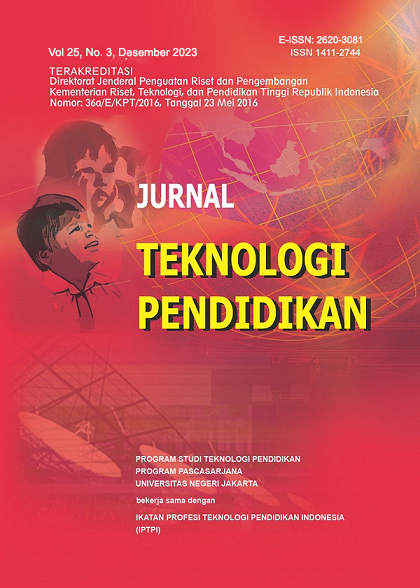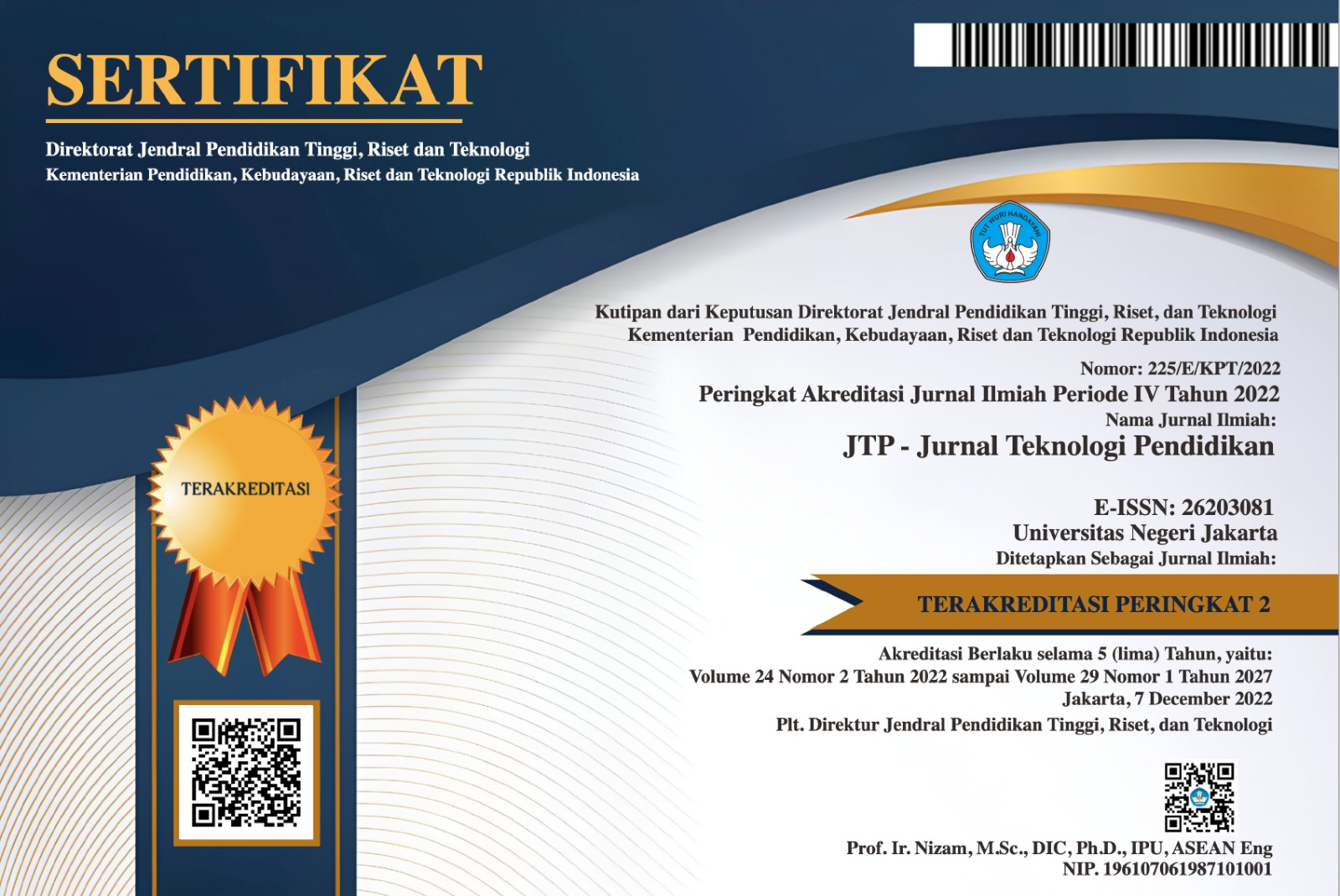Use of Virtual Tour Media Based on Lebak Local Products in Social Studies Learning in Elementary School
DOI:
https://doi.org/10.21009/jtp.v25i3.41529Keywords:
learning, social studies, virtual tour, local Lebak productsAbstract
The virtual tour media based on Lebak local products is designed as an alternative learning media in social studies subjects. Given the situation and conditions at school show that teachers still teach naturally and have not creatively used learning media. The purpose of writing this article is to describe the use of virtual tour media based on Lebak local products in social studies learning so that learning is more meaningful and achieves goals. This research uses quantitative methods with survey techniques and observations of 100 respondents. The data collection technique used a questionnaire distributed to teachers. The results of this study indicate that the use of virtual tour media based on Lebak local products can encourage meaningful learning and achieve learning objectives such as describing Lebak local products including batik cloth, Baduy dyed and woven cloth, crafts, palm sugar and emping as part of the natural wealth and potential of the area where students live, thus encouraging active participation, creativity of students in social studies learning.
References
Asriati, N., & Budiarti, Y. (2012). Mengembangkan Karakter Peserta Didik Berbasis Kearifan Lokal Melalui Pembelajaran di Sekolah. Jurnal Pedidikan Sosiologi Dan Humaniora, 3(2), 106–119. https://doi.org/10.24127/ja.v3i1.143
Banks, James. (1990). Teaching Strategies for The Social Studies: Inquiry, Valuing, and Decision Making. Seattle: University of Washington.Addison Wesley Publishing Company
Fanani, A. (2010). Ice Breaking Dalam Proses Belajar Mengajar. Buana Pendidikan: Jurnal Fakultas Keguruan Dan Ilmu Pendidikan, 6(11), 25–28. https://doi.org/10.1145/3110292.3110316
Hadi, E. samsul. (2020). Inspirasi, 17(1), 254–260.
Handjojo, F. V. (2013). Perancangan Dan Implementasi Aplikasi Content Management System Dengan Format Virtual Online Tour. Jurnal Penelitian Teknik Informatika Vol,1 No 2, 1-6.
Hasni, & Muh.Said. (2020). Implementasi model pembelajaran ips berbasis kearifan lokal di smp nusantara makassar. Supremasi: jurnal pemikiran dan penelitian ilmu-ilmu sosial, hukum, & pengajarannya, 15(1), 82–86.
Jarolimek, J. (1993). Social Studies In Elementary Education. New York: Mc.Millan Publishing.
Kobasa, S. C., Maddi, S. R., & Kahn, S. (1982). Hardiness and health: a prospective study. Journal of Personality and Social Psychology, 42(1), 168.
Lickona, T. (2013). Educating for Character, Mendidik untuk membentuk Karakter (terjemahan. Bumi Aksara)
Maryani, Enok, & Yani, A. (2011). Kearifan Lokal Masyarakat Sunda Dalam Memitigasi Bencana dan Aplikasinya Sebagai Sumber Pembelajaran IPS Berbasis Nilai. Jurnal Penelitian Pendidikan UPI, 14(2), 114–124.
Maryani, Enok, & Yani, A. (2016). Kearifan Lokal Masyarakat Sunda Dalam Memitigasi Bencana Dan Aplikasinya Sebagai Sumber Pembelajaran IPS Berbasis Nilai. Jurnal Penelitian Pendidikan, 14(2). https://doi.org/10.17509/jpp.v14i2.3111
Maryani, Enok. (2014). Pengembangan Program Pembelajaran IPS Untuk Peningkatan Keterampilan Sosial. Alfabeta.
Megawangi, R. (2004). Pendidikan Karakter. Jakarta:Energy.
Meliono, I. (2011). Understanding the Nusantara Thought and Local Wisdom as an Aspect of the Indonesian Education. TAWARIKH: International Journal for Historical Studies, 2(2), 221–234.
Muhson, Ali. (2010).Pengembangan Media Pembelajaran Berbasis Teknologi Informasi . Jurnal Pendidikan Akutansi Indonesia. Vol.VIII, (2), 1-10 DOI: https://doi.org/10.21831/jpai.v8i2.949
Rachmadyanti, P. (2017). Penguatan Pendidikan Karakter Bagi Siswa Sekolah Dasar Melalui Kearifan Lokal. Jurnal Pendidikan Sekolah Dasar, 3(2), 201–213. https://doi.org/10.30870/jpsd.v3i2.2140
Sapriya, dkk. (2006). Konsep Dasar IPS, Bandung: UPI Press
Sugiyono. (2013). Metode Penelitian Kuantitatif, Kualitatif dan R&D. Alfabeta.
Supriatna, N. (2020). Pedagogi Kreatif. Remaja Rosdakarya.
Wafiqni, N., & Nurani, S. (2018). Model Pembelajaran Tematik Berbasis Kearifan Lokal. AL BIDAYAH: Jurnal Pendidikan Dasar Islam, 10(2), 256–268.
Downloads
Published
How to Cite
Issue
Section
License
Copyright (c) 2023 Ajeng Ginanjar, Aim Abdul Karim, Kokom Komalasari, Erlina Wiyanarti

This work is licensed under a Creative Commons Attribution-ShareAlike 4.0 International License.
Jurnal Teknologi Pendidikan is an Open Access Journal. The authors who publish the manuscript in Jurnal Teknologi Pendidikan agree to the following terms.
Attribution-ShareAlike 4.0 International (CC BY-SA 4.0)
-
Attribution — You must give appropriate credit, provide a link to the license, and indicate if changes were made. You may do so in any reasonable manner, but not in any way that suggests the licensor endorses you or your use.
-
ShareAlike — If you remix, transform, or build upon the material, you must distribute your contributions under the same license as the original.
- No additional restrictions — You may not apply legal terms or technological measures that legally restrict others from doing anything the license permits.
Notices:
- You do not have to comply with the license for elements of the material in the public domain or where your use is permitted by an applicable exception or limitation.
- No warranties are given. The license may not give you all of the permissions necessary for your intended use. For example, other rights such as publicity, privacy, or moral rights may limit how you use the material.








